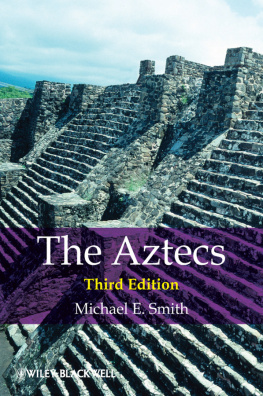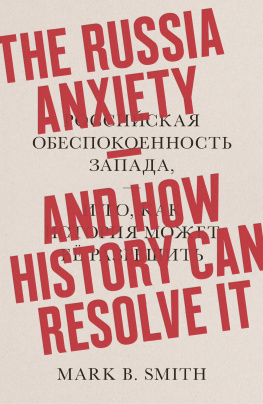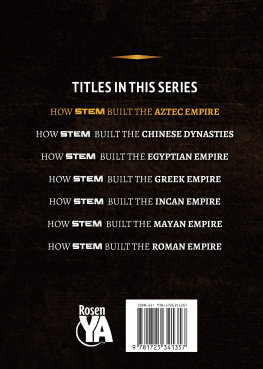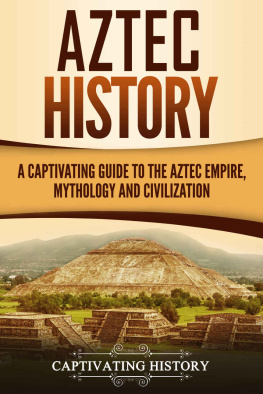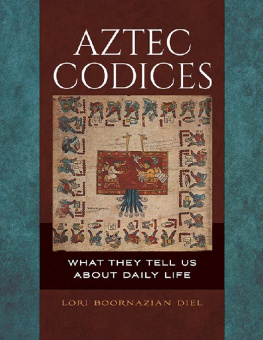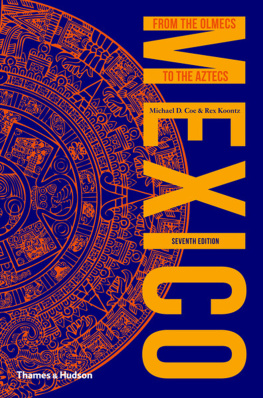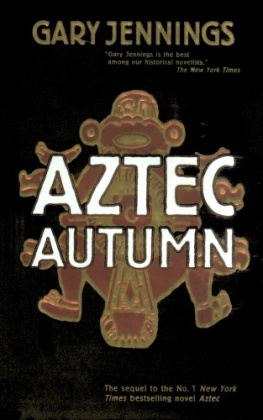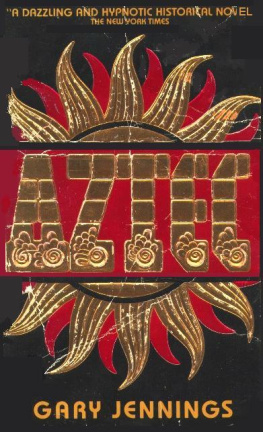The Peoples of America
General Editors: Alan Kolata and Dean Snow
This series is about the native peoples and civilizations of the Americas, from their origins in ancient times to the present day. Drawing on archaeological, historical, and anthropological evidence, each volume presents a fresh and absorbing account of a group's culture, society, and history.
Accessible and scholarly, and well illustrated with maps and photographs, the volumes of The Peoples of America will together provide acomprehensive and vivid picture of the character and variety of the societies of the American past.
Already published:
The Tiwanaku: A Portrait of an Andean Civilization
Alan Kolata
The Timucua
Jerald T. Milanich
The Aztecs
Third Edition
Michael E. Smith
The Cheyenne
John Moore
The Iroquois
Dean Snow
The Moche
Garth Bowden
The Nasca
Helaine Silverman and Donald A. Proulx
The Incas
Terence N. D'Altroy
The Sioux
Guy Gibbon
Mixtecs, Zapotecs, and Chatinos: Ancient Peoples of Southern Mexico
Arthur A. Joyce
This edition first published 2012
2012 Michael E. Smith
Blackwell Publishing was acquired by John Wiley & Sons in February 2007. Blackwell's publishing program has been merged with Wiley's global Scientific, Technical, and Medical business to form Wiley-Blackwell.
Registered Office
John Wiley & Sons Ltd, The Atrium, Southern Gate, Chichester, West Sussex, PO19 8SQ, UK
Editorial Offices
350 Main Street, Malden, MA 02148-5020, USA
9600 Garsington Road, Oxford, OX4 2DQ, UK
The Atrium, Southern Gate, Chichester, West Sussex, PO19 8SQ, UK
For details of our global editorial offices, for customer services, and for information about how to apply for permission to reuse the copyright material in this book please see our website at www.wiley.com/wiley-blackwell .
The right of Michael E. Smith to be identified as the author of this work has been asserted in accordance with the UK Copyright, Designs and Patents Act 1988.
All rights reserved. No part of this publication may be reproduced, stored in a retrieval system, or transmitted, in any form or by any means, electronic, mechanical, photocopying, recording or otherwise, except as permitted by the UK Copyright, Designs and Patents Act 1988, without the prior permission of the publisher.
Wiley also publishes its books in a variety of electronic formats. Some content that appears in print may not be available in electronic books.
Designations used by companies to distinguish their products are often claimed as trademarks. All brand names and product names used in this book are trade names, service marks, trademarks or registered trademarks of their respective owners. The publisher is not associated with any product or vendor mentioned in this book. This publication is designed to provide accurate and authoritative information in regard to the subject matter covered. It is sold on the understanding that the publisher is not engaged in rendering professional services. If professional advice or other expert assistance is required, the services of a competent professional should be sought.
Library of Congress Cataloging-in-Publication Data
Smith, Michael Ernest, 1953
The Aztecs / Michael E. Smith. 3rd ed.
p. cm. (The peoples of America)
Includes bibliographical references and index.
ISBN 978-1-4051-9497-6 (pbk. : alk. paper)
1. AztecsHistory. 2. AztecsAntiquities. 3. AztecsSocial life and customs. 4. MexicoAntiquities. I. Title.
F1219.73.S58 2011
972dc23
2011029132
A catalogue record for this book is available from the British Library.
In memory of William T. Sanders
and Thomas H. Charlton: mentors,
colleagues, friends
Figures
1.1 Artist's reconstruction of the Templo Mayor
1.2 Map of Mesoamerica
1.3 A Mesoamerican tropical forest
1.4 The island capital Tenochtitlan in Aztec times
1.5 Map of Aztec sites in central Mexico
1.6 Typical central Mexican countryside
1.7 Page from an Aztec ritual almanac, the Codex Borgia
1.8 A rural Aztec site
1.9 A small temple platform at the site TA-8 in the Teotihuacan Valley
1.10 Archaeologists collecting surface artifacts
1.11 Excavation of an elite residence at Yautepec
1.12 Mexican antiquities which exist in the National Museum of Mexico, 1857
2.1 Archaeological and native historical chronologies
2.2 Air photo of the ruins of Classic-period Teotihuacan
2.3 Air photo of the ruins of the central ceremonial district of Tula
2.4 Aztec ethnic groups leaving their homeland of Aztlan
2.5 Scene in the Mapa Quinatzin showing Chichimecs and toltecs
2.6 An Early Aztec twin-stair pyramid at Teopanzolco
2.7 A large Early Aztec pyramid at Tenayuca
2.8 Construction stages of the Early Aztec pyramid at Tenayuca
2.9 Genealogy of the Mexica kings
2.10 Cycles of expansion of the Triple Alliance Empire
2.11 Page from the Tira de Tepechpan
2.12 Stone monolith with image of the deity Tlaltecuhtli
2.13 Excavation and cleaning of the Tlaltecuhtli monument
3.1 Schematic map of population growth in the Valley of Mexico
3.2 Mother teaching her 13-year-old daughter to make tortillas
3.3 Traditional maize granary ( cuexcomatl )
3.4 Aztec agricultural terraces at Cerro Texcotzinco
3.5 Aztec embankment built to contain the new channel of the Cuauhtitlan River
3.6 Modern chinampa fields in Xochimilco, ca. 1905
3.7 Maps of Cuexcomate and Capilco
4.1 Obsidian blade-core and four prismatic blades
4.2 Ceramic vessels from Aztec kitchens
4.3 Small ceramic objects from Cuexcomate and Capilco
4.4 Girls being taught by their mothers to spin and weave cotton
4.5 Ceramic cotton-spinning tools from Capilco
4.6 A maguey plant at the Aztec city of Otumba
4.7 Bronze tools from Aztec houses in Yautepec
4.8 Ceremonial featherwork shield
4.9 Master craftsmen instructing their sons in their crafts
4.10 Gold necklace and pendants made by lost-wax casting
4.11 Obsidian ear spools
4.12 Mosaic mask of stone with turquoise, shell, and coral inlay
4.13 Map of Otumba showing areas of craft production
4.14 Technological sequence for the manufacture of obsidian jewelry
5.1 Modern Maya woman selling vegetables in the marketplace
5.2 An Aztec market
5.3 Pochteca merchants
5.4 Cacao pods
5.5 Cacao beans in a gourd
5.6 Sherds from imported Aztec III Black-on-Orange ceramic plates
5.7 Cholula Polychrome ceramic tripod plate
5.8 Imported Valley of Mexico ceramic sherds
6.1 Aztec childbirth customs
6.2 Aztec wedding ceremony
6.3 Wall foundations and floor of a peasant house at Capilco
6.4 Modern adobe peasant house in Tetlama
6.5 Excavation of an urban commoner house at Calixtlahuaca
6.6 Recently excavated commoner house at Xaltocan
6.7 Burial of a commoner woman at Xaltocan
6.8 Artist's reconstruction of the Cuexcomate palace
6.9 Genealogy of the inhabitants of the palace of Molotecatl tecuhtli
6.10 Royal palace of Calixtlahuaca
6.11 Polished red goblet used to drink cacao
7.1 Tax roll from the province of Tlapa
7.2 Map of city-state territories in southeastern Valley of Mexico
7.3 Soldiers carrying maquahuitl swords into battle
7.4 Map of the provinces of the Aztec Empire
7.5 The tax of the imperial province of Coayxtlahuacan
7.6 Entrance to the EagleWarrior Temple
Next page
